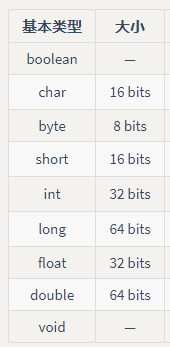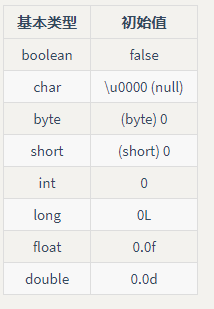对象
new 出来的对象都是保存在堆内存中的
不是使用 new 创建变量,而是使用一个“自动”变量。 这个变量直接存储"值",并置于栈内存中,因此更加高效。
基本类型有自己对应的包装类型,如果你希望在堆内存里表示基本类型的数据,就需要用到它们的包装类
或者使用 自动装箱
Character ch = 'x';

对象作用域
Java 对象与基本类型具有不同的生命周期。当我们使用 new 关键字来创建 Java 对象时,它的生命周期将会超出作用域。
基本类型默认值

无参构造器
一旦你显式地定义了构造器(无论有参还是无参),编译器就不会自动为你创建无参构造器。
this
this就是调用改方法的对象,就像是

或者用去在构造器中调用其他其他构造器
static 方法中不会存在 this。你不能在静态方法中调用非静态方法
static只能用于属性(字段、域) 不能用于局部变量
静态初始化顺序
class Bowl {
Bowl(int marker) {
System.out.println("Bowl(" + marker + ")");
}
void f1(int marker) {
System.out.println("f1(" + marker + ")");
}
}
class Table {
static Bowl bowl1 = new Bowl(1);
Table() {
System.out.println("Table()");
bowl2.f1(1);
}
void f2(int marker) {
System.out.println("f2(" + marker + ")");
}
static Bowl bowl2 = new Bowl(2);
}
class Cupboard {
Bowl bowl3 = new Bowl(3);
static Bowl bowl4 = new Bowl(4);
Cupboard() {
System.out.println("Cupboard()");
bowl4.f1(2);
}
void f3(int marker) {
System.out.println("f3(" + marker + ")");
}
static Bowl bowl5 = new Bowl(5);
}
public class StaticInitialization {
public static void main(String[] args) {
System.out.println("main creating new Cupboard()");
new Cupboard();
System.out.println("main creating new Cupboard()");
new Cupboard();
table.f2(1);
cupboard.f3(1);
}
static Table table = new Table();
static Cupboard cupboard = new Cupboard();
}
==输出:==
Bowl(1)
Bowl(2)
Table()
f1(1)
Bowl(4)
Bowl(5)
Bowl(3)
Cupboard()
f1(2)
main creating new Cupboard()
Bowl(3)
Cupboard()
f1(2)
main creating new Cupboard()
Bowl(3)
Cupboard()
f1(2)
f2(1)
f3(1)
一个java文件里面只能有一个public class
静态属性安申明顺序执行,之后再是构造器
类中的static只会初始化一次
非静态初始化
static{
/* 静态代码块*/
}
{
/*非静态代码块*/
}
==非静态代码块在每次生成对象是都会执行==
// housekeeping/Mugs.java
// Instance initialization
class Mug {
Mug(int marker) {
System.out.println("Mug(" + marker + ")");
}
}
public class Mugs {
Mug mug1;
Mug mug2;
{ // [1]
mug1 = new Mug(1);
mug2 = new Mug(2);
System.out.println("mug1 & mug2 initialized");
}
Mugs() {
System.out.println("Mugs()");
}
Mugs(int i) {
System.out.println("Mugs(int)");
}
public static void main(String[] args) {
System.out.println("Inside main()");
new Mugs();
System.out.println("new Mugs() completed");
new Mugs(1);
System.out.println("new Mugs(1) completed");
}
}
==输出:==
Inside main
Mug(1)
Mug(2)
mug1 & mug2 initialized
Mugs()
new Mugs() completed
Mug(1)
Mug(2)
mug1 & mug2 initialized
Mugs(int)
new Mugs(1) completed
数组的创建
int[] a1 = {1, 2, 3, 4, 5};
int[] a = new int[rand.nextInt(20)];
或者
new String[] {"fiddle", "de", "dum"}
==数组的定义==
int[] a
int a[]
可变参数列表
static void printArray(Object... args)
public class NewVarArgs {
static void printArray(Object... args) {
for (Object obj : args)
System.out.print(obj + "!! ");
System.out.println();
}
public static void main(String[] args) {
// Can take individual elements:
printArray(47, (float) 3.14, 11.11);
printArray(47, 3.14F, 11.11);
printArray("one", "two", "three");
printArray(new A(), new A(), new A());
// Or an array:
printArray((Object[]) new Integer[] { 1, 2, 3, 4 });
printArray(); // Empty list is OK
}
}
==输出:==

==如果把数组传入可变对象参数中,该方法会把它们当作可变参数列表来接受。==





















 275
275











 被折叠的 条评论
为什么被折叠?
被折叠的 条评论
为什么被折叠?








